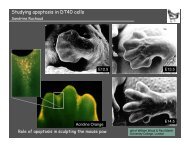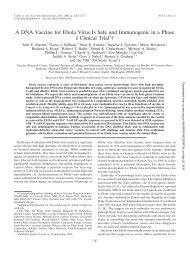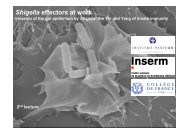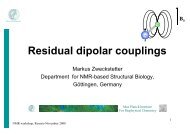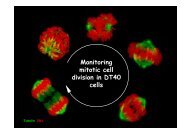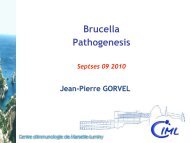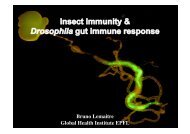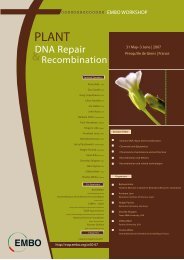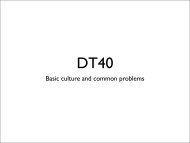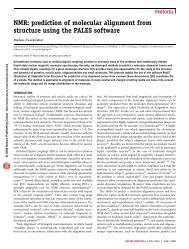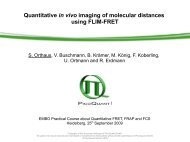Long-Term Control of HIV by CCR5 Delta32 ... - ResearchGate
Long-Term Control of HIV by CCR5 Delta32 ... - ResearchGate
Long-Term Control of HIV by CCR5 Delta32 ... - ResearchGate
You also want an ePaper? Increase the reach of your titles
YUMPU automatically turns print PDFs into web optimized ePapers that Google loves.
From the Department <strong>of</strong> Hematology,<br />
Oncology, and Transfusion Medicine<br />
(G.H., D.N., M.M., S.G., A.M., O.B., I.W.B.,<br />
W.K.H., E.T.) and the Department <strong>of</strong> Gastroenterology,<br />
Infectious Diseases, and<br />
Rheumatology (K.A., T.S.), Campus Benjamin<br />
Franklin; and the Institute <strong>of</strong> Medical<br />
Virology, Campus Mitte (J.H.) — all<br />
at Charité Universitätsmedizin Berlin; and<br />
the Robert Koch Institute (C.K.) — all in<br />
Berlin. Address reprint requests to Dr.<br />
Hütter at Medical Department III Hematology,<br />
Oncology, and Transfusion Medicine,<br />
Charité Campus Benjamin Franklin,<br />
Hindenburgdamm 30 D-12203 Berlin,<br />
Germany, or at gero.huetter@charite.de.<br />
Drs. H<strong>of</strong>mann and Thiel contributed<br />
equally to this article.<br />
N Engl J Med 2009;360:692-8.<br />
Copyright © 2009 Massachusetts Medical Society.<br />
692<br />
The new england journal <strong>of</strong> medicine<br />
brief report<br />
<strong>Long</strong>-<strong>Term</strong> <strong>Control</strong> <strong>of</strong> <strong>HIV</strong> <strong>by</strong> <strong>CCR5</strong> <strong>Delta32</strong>/<br />
<strong>Delta32</strong> Stem-Cell Transplantation<br />
Gero Hütter, M.D., Daniel Nowak, M.D., Maximilian Mossner, B.S.,<br />
Susanne Ganepola, M.D., Arne Müßig, M.D., Kristina Allers, Ph.D.,<br />
Thomas Schneider, M.D., Ph.D., Jörg H<strong>of</strong>mann, Ph.D., Claudia Kücherer, M.D.,<br />
Olga Blau, M.D., Igor W. Blau, M.D., Wolf K. H<strong>of</strong>mann, M.D.,<br />
and Eckhard Thiel, M.D.<br />
Summary<br />
Infection with the human immunodeficiency virus type 1 (<strong>HIV</strong>-1) requires the presence<br />
<strong>of</strong> a CD4 receptor and a chemokine receptor, principally chemokine receptor 5<br />
(<strong>CCR5</strong>). Homozygosity for a 32-bp deletion in the <strong>CCR5</strong> allele provides resistance<br />
against <strong>HIV</strong>-1 acquisition. We transplanted stem cells from a donor who was homozygous<br />
for <strong>CCR5</strong> delta32 in a patient with acute myeloid leukemia and <strong>HIV</strong>-1<br />
infection. The patient remained without viral rebound 20 months after transplantation<br />
and discontinuation <strong>of</strong> antiretroviral therapy. This outcome demonstrates the<br />
critical role <strong>CCR5</strong> plays in maintaining <strong>HIV</strong>-1 infection.<br />
<strong>HIV</strong>-1 enters host cells <strong>by</strong> binding to a CD4 receptor and then<br />
interacting with either <strong>CCR5</strong> or the CXC chemokine receptor (CXCR4). Homozygosity<br />
for a 32-bp deletion (delta32/delta32) in the <strong>CCR5</strong> allele results<br />
in an inactive <strong>CCR5</strong> gene product and consequently confers high resistance against<br />
<strong>HIV</strong>-1 acquisition. 1<br />
Allogeneic stem-cell transplantation from an HLA-matched donor is a feasible<br />
option for patients with hematologic neoplasms, but it has not been established as<br />
a therapeutic option for patients who are also infected with <strong>HIV</strong>. 2 Survival <strong>of</strong> patients<br />
with <strong>HIV</strong> infection has improved considerably since the introduction <strong>of</strong> highly<br />
active antiretroviral therapy (HAART), 3 and as a consequence, successful allogeneic<br />
stem-cell transplantation with ongoing HAART was performed in 2000. 4<br />
In this report, we describe the outcome <strong>of</strong> allogeneic stem-cell transplantation in<br />
a patient with <strong>HIV</strong> infection and acute myeloid leukemia, using a transplant from<br />
an HLA-matched, unrelated donor who was screened for homozygosity for the <strong>CCR5</strong><br />
delta32 deletion.<br />
Case Report<br />
A 40-year-old white man with newly diagnosed acute myeloid leukemia (FAB M4 subtype,<br />
with normal cytogenetic features) presented to our hospital. <strong>HIV</strong>-1 infection<br />
had been diagnosed more than 10 years earlier, and the patient had been treated with<br />
HAART (600 mg <strong>of</strong> efavirenz, 200 mg <strong>of</strong> emtricitabine, and 300 mg <strong>of</strong> ten<strong>of</strong>ovir per<br />
day) for the previous 4 years, during which no illnesses associated with the acquired<br />
immunodeficiency syndrome (AIDS) were observed. At the time that acute mye loid<br />
n engl j med 360;7 nejm.org february 12, 2009<br />
The New England Journal <strong>of</strong> Medicine<br />
Downloaded from www.nejm.org at MPI FUER MOLEKULARE GENETIK on December 9, 2010. For personal use only. No other uses without permission.<br />
Copyright © 2009 Massachusetts Medical Society. All rights reserved.
leukemia was diagnosed, the patient’s CD4 T-cell<br />
count was 415 per cubic millimeter, and <strong>HIV</strong>-1<br />
RNA was not detectable (stage A2 according to<br />
classification <strong>by</strong> the Centers for Disease <strong>Control</strong><br />
and Prevention). Initial treatment <strong>of</strong> the acute<br />
myeloid leukemia consisted <strong>of</strong> two courses <strong>of</strong> induction<br />
chemotherapy and one course <strong>of</strong> consolidation<br />
chemotherapy. During the first induction<br />
course, severe hepatic toxic effects developed<br />
and renal failure occurred. Consequently, HAART<br />
was discontinued, leading to a viral rebound<br />
(6.9×10 6 copies <strong>of</strong> <strong>HIV</strong>-1 RNA per milliliter). The<br />
therapy was resumed immediately, before a viral<br />
steady state was reached, and 3 months later,<br />
<strong>HIV</strong>-1 RNA was undetectable.<br />
Seven months after presentation, acute myeloid<br />
leukemia relapsed, and the patient underwent<br />
allogeneic stem-cell transplantation with CD34+<br />
peripheral-blood stem cells from an HLA-identical<br />
donor who had been screened for homozygosity<br />
for the <strong>CCR5</strong> delta32 allele. The patient provided<br />
informed consent for this procedure, and the protocol<br />
was approved <strong>by</strong> the institutional review<br />
board. The HLA genotypes <strong>of</strong> the patient and the<br />
donor were identical at the following loci: A*0201;<br />
B*0702,3501; Cw*0401,0702; DRB1*0101,1501; and<br />
DQB1*0501,0602. The patient underwent a conditioning<br />
regimen and received a graft containing<br />
2.3×10 6 CD34+ cells per kilogram <strong>of</strong> body weight. 5<br />
Prophylaxis against graft-versus-host disease consisted<br />
<strong>of</strong> 0.5 mg <strong>of</strong> rabbit antithymocyte globulin<br />
per kilogram 3 days before transplantation, 2.5 mg<br />
per kilogram 2 days before, and 2.5 mg per kilogram<br />
1 day before. The patient received two doses<br />
<strong>of</strong> 2.5 mg <strong>of</strong> cyclosporine per kilogram intravenously<br />
1 day before the procedure and treatment<br />
with mycophenolate m<strong>of</strong>etil at a dose <strong>of</strong> 1 g three<br />
times per day was started 6 hours after transplantation.<br />
HAART was administered until the day<br />
before the procedure, and engraftment was achieved<br />
13 days after the procedure. Except for the presence<br />
<strong>of</strong> grade I graft-versus-host disease <strong>of</strong> the<br />
skin, which was treated <strong>by</strong> adjusting the dosage<br />
<strong>of</strong> cyclosporine, there were no serious infections<br />
or toxic effects other than grade I during the first<br />
year <strong>of</strong> follow-up. Acute myeloid leukemia relapsed<br />
332 days after transplantation, and chimerism<br />
transiently decreased to 15%. The patient underwent<br />
reinduction therapy with cytarabine and<br />
gemtuzumab and on day 391 received a second<br />
transplant, consisting <strong>of</strong> 2.1×10 6 CD34+ cells per<br />
kilogram, from the same donor, after treatment<br />
Brief Report<br />
with a single dose <strong>of</strong> whole-body irradiation (200<br />
cGy). The second procedure led to a complete remission<br />
<strong>of</strong> the acute myeloid leukemia, which was<br />
still in remission at month 20 <strong>of</strong> follow-up.<br />
Methods<br />
<strong>CCR5</strong> Genotyping<br />
Genomic DNA was extracted from heparinized<br />
peripheral-blood monocytes obtained from the patient<br />
and the prospective donor, with the use <strong>of</strong><br />
the QIAamp Blood Midi Kit (Qiagen). Screening <strong>of</strong><br />
donors for the <strong>CCR5</strong> delta32 allele was performed<br />
with a genomic polymerase-chain-reaction (PCR)<br />
assay, with primers flanking the site <strong>of</strong> the deletion<br />
(forward, 5′CTCCCAGGAATCATCTTTACC3′;<br />
reverse, 5′TCATTTCGACACCGAAGCAG3′), resulting<br />
in a PCR fragment <strong>of</strong> 200 bp for the <strong>CCR5</strong> allele<br />
and 168 bp for a delta32 deletion. Results were confirmed<br />
<strong>by</strong> allele-specific PCR and <strong>by</strong> direct sequencing<br />
with the use <strong>of</strong> the BigDye <strong>Term</strong>inator v1.1<br />
Cycle Sequencing Kit (Applied Biosystems). Sequences<br />
were analyzed with the use <strong>of</strong> Vector NTI<br />
ContigExpress s<strong>of</strong>tware (Invitrogen).<br />
Viral-Envelope Genotyping<br />
Coreceptor use <strong>by</strong> <strong>HIV</strong>-1 was assessed through V3<br />
amino acid sequences <strong>of</strong> the env region for both<br />
DNA and RNA. Bulk PCR products were subjected<br />
to direct sequencing and determined according to<br />
the 11/25 and net charge rules, as described <strong>by</strong><br />
Delobel et al. 6<br />
For RNA, the <strong>HIV</strong> env region was sequenced<br />
from position 6538 to 6816 and Web positionspecific<br />
scoring matrix (WebPSSM), and geno2pheno<br />
bioinformatic s<strong>of</strong>tware was used to predict<br />
viral coreceptor use. In addition, an ultradeep PCR<br />
analysis with parallel sequencing (454-Life-Sciences,<br />
Roche) was performed. 7<br />
Chemokine Receptors and Surface Antigens<br />
Mucosal cells were isolated from 10 rectal-biopsy<br />
specimens according to the method <strong>of</strong> Moos et al. 8<br />
<strong>CCR5</strong> expression was stimulated <strong>by</strong> phytohemagglutinin<br />
(Sigma), and the cells were analyzed <strong>by</strong><br />
means <strong>of</strong> flow cytometry with the use <strong>of</strong> antibodies<br />
against CD3, CD4, CD11c, CD163, and <strong>CCR5</strong><br />
(BD Biosciences).<br />
Chimerism<br />
Standard chimerism analyses were based on the<br />
discrimination between donor and recipient alleles<br />
n engl j med 360;7 nejm.org february 12, 2009 693<br />
The New England Journal <strong>of</strong> Medicine<br />
Downloaded from www.nejm.org at MPI FUER MOLEKULARE GENETIK on December 9, 2010. For personal use only. No other uses without permission.<br />
Copyright © 2009 Massachusetts Medical Society. All rights reserved.
Figure 1. Genotyping <strong>of</strong> <strong>CCR5</strong> Alleles.<br />
AUTHOR:<br />
RETAKE 1st<br />
Polymerase-chain-reaction ICM (PCR) Hütter assays reveal the genotyping patterns <strong>of</strong><br />
FIGURE:<br />
2nd<br />
different <strong>CCR5</strong> REG alleles F and the 1 phenotype <strong>of</strong> 4 <strong>of</strong> the <strong>HIV</strong>-1 envelope. Amplifica-<br />
3rd<br />
tion <strong>of</strong> the homozygous CASE wild-type allele (<strong>CCR5</strong>+/+) results Revised in a single band<br />
<strong>of</strong> 200 bp. The EMail sample that is homozygous Line for the 4-C <strong>CCR5</strong> delta32 SIZE allele<br />
ARTIST: ts<br />
(<strong>CCR5</strong> delta32/delta32) H/T H/T<br />
Enon produces a single band <strong>of</strong> 168 bp. 22p3 Before stem-cell<br />
Combo<br />
transplantation (SCT), the patient had a heterozygous genotype (<strong>CCR5</strong>+/<br />
delta32); after transplantation, AUTHOR, with ongoing PLEASE NOTE: engraftment, the genotype<br />
Figure has been redrawn and type has been reset.<br />
changed to <strong>CCR5</strong> delta32/delta32. Please Samples check carefully. containing heterozygous alleles<br />
produce both bands, plus an additional third band that may be an artifact<br />
arising from JOB: secondary 36007 structures <strong>of</strong> PCR products. ISSUE: 02-12-09<br />
694<br />
<strong>CCR5</strong>+/+<br />
<strong>CCR5</strong>+/delta32<br />
<strong>CCR5</strong> delta32/delta32<br />
on short tandem repeats, with the use <strong>of</strong> PCR and<br />
fluorescence-labeled primers according to the<br />
method <strong>of</strong> Blau et al. 9<br />
Cellular and Humoral Immune Responses<br />
Secretion <strong>of</strong> interferon-γ <strong>by</strong> antigen-specific cells<br />
was induced according to the method <strong>of</strong> Ganepola<br />
et al. 10 For measurement <strong>of</strong> T-cell–mediated<br />
immune responses, two HLA-A*0201–binding peptides<br />
were used: <strong>HIV</strong>-1 476–484 (ILKEPVHGV) and<br />
cytomegalovirus (CMV) 65–73 (NLVPMVATV). The<br />
presence <strong>of</strong> antibodies against <strong>HIV</strong>-1 and <strong>HIV</strong><br />
type 2 (<strong>HIV</strong>-2) was determined <strong>by</strong> means <strong>of</strong> an<br />
enzyme-linked immunoassay and immunoblot assays<br />
in accordance with the procedures recommended<br />
<strong>by</strong> the manufacturers (Abbott and Immogenetics).<br />
Amplification <strong>of</strong> <strong>HIV</strong>-1 RNA and DNA<br />
<strong>HIV</strong>-1 RNA was isolated from plasma and amplif<br />
ied with the use <strong>of</strong> the Cobas Ampli Prep–TaqMan<br />
<strong>HIV</strong> assay system (Roche). Total DNA was isolated<br />
from peripheral-blood monocytes and rectal-biopsy<br />
specimens with the use <strong>of</strong> the QIAamp DNA Blood<br />
Mini Kit and the AllPrep DNA/RNA Mini Kit, respectively<br />
(both from Qiagen). The env and longterminal-repeat<br />
regions were amplified accord-<br />
The new england journal <strong>of</strong> medicine<br />
Patient, before SCT<br />
Patient, Day 61<br />
200 bp<br />
168 bp<br />
n engl j med 360;7 nejm.org february 12, 2009<br />
ing to the method <strong>of</strong> Cassol et al. and Drosten et<br />
al. 11,12 The sensitivity <strong>of</strong> the RNA assay was 40 copies<br />
per milliliter, and the lower limit <strong>of</strong> detection<br />
for both complementary DNA (cDNA) PCR assays<br />
is 5 copies per reaction, with a positivity rate <strong>of</strong><br />
more than 95%. Each assay contained 2×10 4 to<br />
5×10 4 CD4+ T cells. The successful amplification<br />
<strong>of</strong> 1 μg <strong>of</strong> cellular DNA extracted from various<br />
housekeeping genes (GAPDH, <strong>CCR5</strong>, and CD4) extracted<br />
from 1 μg cellular DNA indicated the suitability<br />
<strong>of</strong> the DNA isolated from the mucosal<br />
specimens.<br />
Results<br />
Distribution <strong>of</strong> <strong>CCR5</strong> Alleles<br />
Genomic DNA from 62 <strong>of</strong> 80 potential HLA-identical<br />
stem-cell donors registered at the German<br />
Bone Marrow Donor Center was sequenced in the<br />
<strong>CCR5</strong> region. The frequencies <strong>of</strong> the delta32 allele<br />
and the wild-type allele were 0.21 and 0.79, respectively.<br />
Only one donor was homozygous for the<br />
<strong>CCR5</strong> delta32 deletion in this cohort.<br />
Analysis <strong>of</strong> <strong>HIV</strong>-1 Coreceptor Phenotype<br />
Sequence analysis <strong>of</strong> the patient’s viral variants revealed<br />
a glycine at position 11 and a glutamic acid<br />
at position 25 <strong>of</strong> the V3 region. The net charge <strong>of</strong><br />
amino acids was +3. These results indicated <strong>CCR5</strong><br />
coreceptor use <strong>by</strong> the <strong>HIV</strong>-1 strain infecting the<br />
patient, a finding that was confirmed <strong>by</strong> sequencing<br />
RNA in the <strong>HIV</strong> env region. The ultradeep sequencing<br />
analysis revealed a proportion <strong>of</strong> 2.9%<br />
for the X4 and dual-tropic variants combined.<br />
Recipient Chimerism<br />
With ongoing engraftment, the PCR patterns <strong>of</strong><br />
<strong>CCR5</strong> were transformed, indicating a shift from a<br />
heterozygous genotype to a homozygous delta32/<br />
delta32 genotype (Fig. 1). Complete chimerism,<br />
determined on the basis <strong>of</strong> allelic short tandem<br />
repeats, was obtained 61 days after allogeneic stemcell<br />
transplantation.<br />
Cellular and Humoral Immune Responses<br />
T-cell responses to defined HLA-A2–restricted antigens,<br />
determined with the use <strong>of</strong> an interferon-γ<br />
enzyme-linked immunospot assay, revealed elevated<br />
frequencies <strong>of</strong> <strong>HIV</strong>-specific T cells before<br />
stem-cell transplantation and undetectable frequencies<br />
after transplantation (Fig. 2A). Immunoblot<br />
analysis revealed a predominant loss <strong>of</strong> antibodies<br />
to polymerase and capsid proteins after<br />
The New England Journal <strong>of</strong> Medicine<br />
Downloaded from www.nejm.org at MPI FUER MOLEKULARE GENETIK on December 9, 2010. For personal use only. No other uses without permission.<br />
Copyright © 2009 Massachusetts Medical Society. All rights reserved.
No. <strong>of</strong> Spots/100,00 Cells<br />
10 4<br />
10 3<br />
10 2<br />
10<br />
1<br />
0<br />
transplantation, whereas levels <strong>of</strong> antibodies to<br />
soluble glycoprotein 120 and glycoprotein 41 remained<br />
detectable (Fig. 2B).<br />
Quantification <strong>of</strong> Viremia<br />
The <strong>HIV</strong>-1 load was measured with the use <strong>of</strong> RNA<br />
and DNA PCR assays (Fig. 3). Throughout the follow-up<br />
period, serum levels <strong>of</strong> <strong>HIV</strong>-1 RNA remained<br />
undetectable. Also during follow-up, the semiquantitative<br />
assay showed no detectable proviral DNA<br />
except on the 20th day after transplantation, for<br />
both the env and long-terminal-repeat loci, and on<br />
the 61st day after transplantation, for the env locus.<br />
Rectal-Biopsy Specimens<br />
In rectal-biopsy specimens obtained 159 days after<br />
transplantation, macrophages showed expression<br />
<strong>of</strong> <strong>CCR5</strong>, whereas a distinct <strong>CCR5</strong>-expressing population<br />
was not present in the mucosal CD4+<br />
T lymphocytes (Fig. 4).<br />
Discussion<br />
To enter target cells, <strong>HIV</strong>-1 requires both CD4 and<br />
a coreceptor, predominantly <strong>CCR5</strong>. Blocking <strong>of</strong><br />
the preferentially used <strong>CCR5</strong> receptor <strong>by</strong> inhibitors<br />
or through gene knockdown conferred anti-<br />
Brief Report<br />
A B<br />
CMV<br />
<strong>HIV</strong><br />
0 50 100 150 200 250 300 350<br />
Days after SCT<br />
sgp120<br />
gp41<br />
p31<br />
p24<br />
p17<br />
sgp105<br />
sgp36<br />
1 2 3 4<br />
<strong>Control</strong>s<br />
<strong>HIV</strong>-1 env<br />
<strong>HIV</strong>-1 pol<br />
<strong>HIV</strong>-1 gag<br />
<strong>HIV</strong>-2 env<br />
Figure 2. Cellular and Humoral Immune Response to <strong>HIV</strong>-1.<br />
AUTHOR: Hütter<br />
RETAKE 1st<br />
The results <strong>of</strong> interferon-γ enzyme-linked ICM immunospot assays are plotted as the mean number <strong>of</strong> spots per 100,000<br />
REG F FIGURE:<br />
2nd<br />
peripheral-blood monocytes (Panel A). A positive<br />
2<br />
response<br />
<strong>of</strong> 4<br />
was defined as more than 3rd 20 spots per 100,000 monocytes.<br />
T-cell reactivity was tested against CASE <strong>HIV</strong>-1476–484 (ILKEPVHGV) and cytomegalovirus Revised (CMV) 65-73 (NLVPMVATV).<br />
Whereas specific T-cell responses EMail against CMV increased after Line transplantation, 4-C<br />
SIZE the patient lost T-cell reactivity<br />
ARTIST: ts<br />
against <strong>HIV</strong>. The results <strong>of</strong> immunoblot H/T H/T<br />
Enon analysis <strong>of</strong> <strong>HIV</strong> antigens (Panel B) are 33p9 shown for a positive control (lane 1),<br />
Combo<br />
a sample obtained from the patient 14 days before stem-cell transplantation (SCT) (lane 2), a sample obtained from<br />
AUTHOR, PLEASE NOTE:<br />
the patient 625 days after transplantation (lane 3), and a negative control (lane 4). Whereas antibodies against enve-<br />
Figure has been redrawn and type has been reset.<br />
lope proteins still remained detectable in lane 3, the Please number check carefully. <strong>of</strong> antibodies against polymerase and capsid proteins<br />
declined markedly. The abbreviation sgp denotes soluble glycoprotein, gp glycoprotein, and p protein.<br />
JOB: 36007 ISSUE: 02-12-09<br />
viral protection to R5-tropic variants. 13,14 The homozygous<br />
<strong>CCR5</strong> delta32 deletion, observed in<br />
approximately 1% <strong>of</strong> the white population, <strong>of</strong>fers<br />
a natural resistance to <strong>HIV</strong> acquisition. We report<br />
a successful transplantation <strong>of</strong> allogeneic stem cells<br />
homozygous for the <strong>CCR5</strong> delta32 allele to a patient<br />
with <strong>HIV</strong>.<br />
Although discontinuation <strong>of</strong> antiretroviral therapy<br />
typically leads to a rapid rebound <strong>of</strong> <strong>HIV</strong> load<br />
within weeks, in this patient, no active, replicating<br />
<strong>HIV</strong> could be detected 20 months after HAART<br />
had been discontinued. 15 This observation is remarkable<br />
because homozygosity for <strong>CCR5</strong> delta32<br />
is associated with high but not complete resistance<br />
to <strong>HIV</strong>-1. This outcome can be explained <strong>by</strong><br />
the behavior <strong>of</strong> non-<strong>CCR5</strong>-tropic variants, such<br />
as CXCR4-tropic viruses (X4), which are able to<br />
use CXCR4 as a coreceptor. The switch occurs in<br />
the natural course <strong>of</strong> infection, and the proportion<br />
<strong>of</strong> X4 increases with ongoing HAART. 16 Genotypic<br />
and phenotypic assays can be used to determine<br />
the nature and extent <strong>of</strong> coreceptor use, but the<br />
presence <strong>of</strong> heterogeneous viral populations in<br />
samples from patients limits the sensitivity <strong>of</strong><br />
the assay. 17 When genotypic analysis was performed<br />
in two laboratories applying WebPSSM<br />
and geno2 pheno prediction algorithms, X4 vari-<br />
n engl j med 360;7 nejm.org february 12, 2009 695<br />
The New England Journal <strong>of</strong> Medicine<br />
Downloaded from www.nejm.org at MPI FUER MOLEKULARE GENETIK on December 9, 2010. For personal use only. No other uses without permission.<br />
Copyright © 2009 Massachusetts Medical Society. All rights reserved.
696<br />
<strong>HIV</strong>-1 RNA<br />
(copies/ml)<br />
CD4+ T Cells<br />
(per mm3 )<br />
10 7<br />
10 6<br />
10 5<br />
10 4<br />
10 3<br />
10 2<br />
400<br />
300<br />
200<br />
100<br />
0<br />
Treatment<br />
AML diagnosis<br />
ants were not detected in the plasma <strong>of</strong> our patient.<br />
To determine the proportion <strong>of</strong> minor variants<br />
in the plasma, we performed an ultradeep<br />
sequencing analysis, which revealed a small proportion<br />
<strong>of</strong> X4 variants before the allogeneic stemcell<br />
transplantation.<br />
Even after prolonged HAART, the persistence<br />
<strong>of</strong> <strong>HIV</strong>-1 populations in various anatomical compartments<br />
can be observed in patients without<br />
detectable viremia. 18 In particular, the intestinal<br />
lamina propria represents an important reservoir<br />
The new england journal <strong>of</strong> medicine<br />
HAART HAART<br />
AML relapse<br />
First SCT<br />
100% Chimerism<br />
−227 −206 −85 −4 +61 +108 +159 +332 +391 +416 +548<br />
−227 −206 −85 −4 +61 +108 +159 +332 +391 +416 +548<br />
Days before or after SCT<br />
Rectal biopsy<br />
ATG<br />
MMF<br />
MMF<br />
Cs Cs<br />
Cx Cx Cx Cx<br />
TBI<br />
Cx TBI<br />
Figure 3. Clinical Course and <strong>HIV</strong>-1 Viremia.<br />
The clinical course and treatment AUTHOR:<br />
RETAKE<br />
ICM <strong>of</strong> acute myeloid Hütterleukemia<br />
(AML) as well as 1st <strong>HIV</strong> and the measurement <strong>of</strong> <strong>HIV</strong>-1<br />
REG F FIGURE:<br />
2nd<br />
viremia <strong>by</strong> means <strong>of</strong> RNA polymerase-chain-reaction 3 <strong>of</strong> 4 assays are shown from the point <strong>of</strong> AML diagnosis to day 548<br />
3rd<br />
after stem-cell transplantation CASE (SCT). <strong>HIV</strong>-1 RNA was not detected in Revised peripheral blood or bone marrow from the<br />
point at which highly active antiretroviral EMail therapy (HAART) Line was 4-C discontinued, SIZE 1 day before SCT, until the end <strong>of</strong> fol-<br />
ARTIST: ts<br />
low-up, 548 days after SCT. (The H/T H/T<br />
Enonshaded<br />
area <strong>of</strong> this graph indicates the limit<br />
Combo<br />
33p9<br />
<strong>of</strong> detection <strong>of</strong> the <strong>HIV</strong>–RNA assay.)<br />
The CD4+ T-cell count in the peripheral blood is shown in reference to the immunosuppressive treatments. ATG denotes<br />
antithymocyte globulin, Cs cyclosporine, AUTHOR, Cx chemotherapy, PLEASE NOTE: MMF mycophenolate m<strong>of</strong>etil, and TBI total-body<br />
Figure has been redrawn and type has been reset.<br />
irradiation.<br />
Please check carefully.<br />
JOB: 36007 ISSUE: 02-12-09<br />
n engl j med 360;7 nejm.org february 12, 2009<br />
AML relapse<br />
Second SCT<br />
100% Chimerism<br />
<strong>of</strong> <strong>HIV</strong>-1, and genomic virus detection is possible<br />
in patients without viremia. 19 In this patient,<br />
a rectal biopsy performed 159 days after transplantation<br />
revealed that <strong>CCR5</strong>-expressing macrophages<br />
were still present in the intestinal mucosa,<br />
indicating that they had not yet been replaced<br />
<strong>by</strong> the new immune system. Although these longlasting<br />
cells from the host can represent viral<br />
reservoirs even after transplantation, <strong>HIV</strong>-1 DNA<br />
could not be detected in this patient’s rectal<br />
mucosa.<br />
The New England Journal <strong>of</strong> Medicine<br />
Downloaded from www.nejm.org at MPI FUER MOLEKULARE GENETIK on December 9, 2010. For personal use only. No other uses without permission.<br />
Copyright © 2009 Massachusetts Medical Society. All rights reserved.
A Mucosal Monocytes<br />
CD4+<br />
B Mucosal CD4+ Cells<br />
CD163+<br />
It is likely that X4 variants remained in other<br />
anatomical reservoirs as potential sources for reemerging<br />
viruses, but the number <strong>of</strong> X4-tropic infectious<br />
particles after transplantation could have<br />
been too low to allow reseeding <strong>of</strong> the patient’s<br />
replaced immune system.<br />
The loss <strong>of</strong> anti-<strong>HIV</strong>, virus-specific, interferonγ–producing<br />
T-cells during follow-up suggests that<br />
<strong>HIV</strong> antigen stimulation was not present after<br />
transplantation. This disappearance <strong>of</strong> effector<br />
T cells was not associated with a deficient immune<br />
reconstitution, as shown <strong>by</strong> the absence <strong>of</strong> relevant<br />
infection or reactivation <strong>of</strong> other persistent<br />
viruses, such as CMV and Epstein–Barr virus.<br />
Thus, the absence <strong>of</strong> measurable <strong>HIV</strong> viremia in<br />
our patient probably represents the removal <strong>of</strong> the<br />
Brief Report<br />
Figure 4. Expression <strong>of</strong> CD Surface Antigen and Chemokine Coreceptor in the Patient’s Rectal Mucosa.<br />
AUTHOR: Hütter<br />
RETAKE 1st<br />
Mucosal cells isolated from rectal-biopsy ICM specimens obtained 159 days after stem-cell transplantation were activat-<br />
REG F FIGURE: 4 <strong>of</strong> 4<br />
2nd<br />
ed <strong>by</strong> phytohemagglutinin and analyzed with the use <strong>of</strong> flow cytometry. Cells were 3rd gated for lymphocytes <strong>by</strong> their<br />
characteristic forward- and side-scatter CASE pr<strong>of</strong>ile and were analyzed for <strong>CCR5</strong> Revised expression within the CD4+ T-cell population<br />
(Panel A). Macrophages were EMail identified as CD11c+ and<br />
Line<br />
CD163+<br />
4-C<br />
within the SIZECD4+<br />
cell gate and analyzed for<br />
ARTIST: ts<br />
<strong>CCR5</strong> expression (Panel B). Whereas<br />
H/T H/T<br />
Enonintestinal<br />
CD4+ T lymphocytes were negative 33p9 (0.0%) for <strong>CCR5</strong> expression,<br />
Combo<br />
14.6% <strong>of</strong> macrophages expressed <strong>CCR5</strong> after engraftment, indicating a complete exchange <strong>of</strong> intestinal CD3+/CD4+<br />
AUTHOR, PLEASE NOTE:<br />
lymphocytes but not <strong>of</strong> intestinal CD3+/CD4+ Figure has macrophages.<br />
been redrawn and type has been reset.<br />
Please check carefully.<br />
Count<br />
CD3+ <strong>CCR5</strong>+<br />
Count<br />
CD11c+ <strong>CCR5</strong>+<br />
JOB: 36007 ISSUE: 02-12-09<br />
14.6%<br />
<strong>HIV</strong> immunologic stimulus. 20 Antibodies against<br />
<strong>HIV</strong>-envelope antigens have remained detectable,<br />
but at continually decreasing levels. The sustained<br />
secretion <strong>of</strong> antibodies might be caused <strong>by</strong> longlived<br />
plasma cells that are relatively resistant to<br />
common immunosuppressive therapies. 21,22<br />
In the past, there were several attempts to control<br />
<strong>HIV</strong>-1 infection <strong>by</strong> means <strong>of</strong> allogeneic stemcell<br />
transplantation without regard to the donor’s<br />
<strong>CCR5</strong> delta32 status, but these efforts were not successful.<br />
23 In our patient, transplantation led to<br />
complete chimerism, and the patient’s peripheralblood<br />
monocytes changed from a heterozygous to<br />
a homozygous genotype regarding the <strong>CCR5</strong> delta32<br />
allele. Although the patient had non–<strong>CCR5</strong>tropic<br />
X4 variants and HAART was discontinued<br />
n engl j med 360;7 nejm.org february 12, 2009 697<br />
The New England Journal <strong>of</strong> Medicine<br />
Downloaded from www.nejm.org at MPI FUER MOLEKULARE GENETIK on December 9, 2010. For personal use only. No other uses without permission.<br />
Copyright © 2009 Massachusetts Medical Society. All rights reserved.<br />
0.0%
698<br />
for more than 20 months, <strong>HIV</strong>-1 virus could not<br />
be detected in peripheral blood, bone marrow, or<br />
rectal mucosa, as assessed with RNA and proviral<br />
DNA PCR assays. For as long as the viral load continues<br />
to be undetectable, this patient will not require<br />
antiretroviral therapy. Our findings underscore<br />
the central role <strong>of</strong> the <strong>CCR5</strong> receptor during<br />
<strong>HIV</strong>-1 infection and disease progression and should<br />
encourage further investigation <strong>of</strong> the development<br />
<strong>of</strong> <strong>CCR5</strong>-targeted treatment options.<br />
Supported <strong>by</strong> a grant from the German Research Foundation<br />
(DFG KFO grant 104 1/1).<br />
Dr. H<strong>of</strong>mann reports serving as a consultant or advisoryboard<br />
member and on speakers’ bureaus for Celgene and Novar-<br />
References<br />
1. Liu R, Paxton WA, Choe S, et al. Homozygous<br />
defect in <strong>HIV</strong>-1 coreceptor accounts<br />
for resistance <strong>of</strong> some multiplyexposed<br />
individuals to <strong>HIV</strong>-1 infection.<br />
Cell 1996;86:367-77.<br />
2. Ayash LJ, Ratanatharathorn V, Braun<br />
T, Silver SM, Reynolds CM, Uberti JP. Unrelated<br />
donor bone marrow transplantation<br />
using a chemotherapy-only preparative<br />
regimen for adults with high-risk acute<br />
myelogenous leukemia. Am J Hematol<br />
2007;82:6-14.<br />
3. Palella FJ Jr, Delaney KM, Moorman<br />
AC, et al. Declining morbidity and mortality<br />
among patients with advanced human<br />
immunodeficiency virus infection.<br />
N Engl J Med 1998;338:853-60.<br />
4. Sora F, Antinori A, Piccirillo N, et al.<br />
Highly active antiretroviral therapy and allogeneic<br />
CD34(+) peripheral blood progenitor<br />
cells transplantation in an <strong>HIV</strong>/HCV<br />
coinfected patient with acute myeloid leukemia.<br />
Exp Hematol 2002;30:279-84.<br />
5. Schmid C, Weisser M, Ledderose G,<br />
Stötzer O, Schleuning M, Kolb HJ. Dosereduced<br />
conditioning before allogeneic<br />
stem cell transplantation: principles, clinical<br />
protocols and preliminary results. Dtsch<br />
Med Wochenschr 2002;127:2186-92. (In<br />
German.)<br />
6. Delobel P, Nugeyre MT, Cazabat M, et<br />
al. Population-based sequencing <strong>of</strong> the V3<br />
region <strong>of</strong> env for predicting the coreceptor<br />
usage <strong>of</strong> human immunodeficiency<br />
virus type 1 quasispecies. J Clin Microbiol<br />
2007;45:1572-80.<br />
7. Däumer M, Kaiser R, Klein R, Lengauer<br />
T, Thiele B, Thielen A. Inferring viral<br />
tropism from genotype with massively<br />
parallel sequencing: qualitative and quantitative<br />
analysis. Presented at the XVII International<br />
<strong>HIV</strong> Drug Resistance Workshop,<br />
Sitges, Spain, June 10–14, 2008.<br />
Brief Report<br />
(Accessed January 26, 2009, at http://<br />
domino.mpi-inf.mpg.de/intranet/ag3/<br />
ag3publ.nsf/MPGPublications?OpenAgent<br />
&LastYear.)<br />
8. Moos V, Kunkel D, Marth T, et al. Reduced<br />
peripheral and mucosal Tropheryma<br />
whipplei-specific Th1 response in patients<br />
with Whipple’s disease. J Immunol<br />
2006;177:2015-22.<br />
9. Blau IW, Schmidt-Hieber M, Leschinger<br />
N, et al. Engraftment kinetics and<br />
hematopoietic chimerism after reducedintensity<br />
conditioning with fludarabine and<br />
treosulfan before allogeneic stem cell transplantation.<br />
Ann Hematol 2007;86:583-9.<br />
10. Ganepola S, Gentilini C, Hilbers U, et<br />
al. Patients at high risk for CMV infection<br />
and disease show delayed CD8+ T-cell immune<br />
recovery after allogeneic stem cell<br />
transplantation. Bone Marrow Transplant<br />
2007;39:293-9.<br />
11. Cassol S, Salas T, Arella M, Neumann<br />
P, Schechter MT, O’Shaughnessy M. Use<br />
<strong>of</strong> dried blood spot specimens in the detection<br />
<strong>of</strong> human immunodeficiency virus<br />
type 1 <strong>by</strong> the polymerase chain reaction.<br />
J Clin Microbiol 1991;29:667-71.<br />
12. Drosten C, Seifried E, Roth WK. Taq-<br />
Man 5′-nuclease human immunodeficiency<br />
virus type 1 PCR assay with phagepackaged<br />
competitive internal control for<br />
high-throughput blood donor screening.<br />
J Clin Microbiol 2001;39:4302-8.<br />
13. Mueller MC, Bogner JR. Treatment<br />
with <strong>CCR5</strong> antagonists: which patient may<br />
have a benefit? Eur J Med Res 2007;12:441-<br />
52.<br />
14. Anderson J, Akkina R. Complete<br />
knockdown <strong>of</strong> <strong>CCR5</strong> <strong>by</strong> lentiviral vectorexpressed<br />
siRNAs and protection <strong>of</strong> transgenic<br />
macrophages against <strong>HIV</strong>-1 infec-<br />
tion. Gene Ther 2007;14:1287-97.<br />
15. Jubault V, Burgard M, Le Corfec E,<br />
n engl j med 360;7 nejm.org february 12, 2009<br />
tis. No other potential conflict <strong>of</strong> interest relevant to this article<br />
was reported.<br />
We thank Alexander Schmidt, Petra Leuker, and Gerhard Ehninger<br />
(German Bone Marrow Center, Tübingen and Dresden,<br />
Germany) for their encouragement and cooperation regarding access<br />
<strong>of</strong> donor blood samples; Emil Morsch (Stefan Morsch Foundation,<br />
Birkenfeld, Germany) and Martin Meixner (Department <strong>of</strong><br />
Biochemistry, Charité Universitätsmedizin, Berlin) for performing<br />
sequencing; Stephan Fuhrmann and Mathias Streitz (Department<br />
<strong>of</strong> Immunology, Charité Universitätsmedizin, Berlin) for providing<br />
<strong>HIV</strong> p24 antigens; Alexander Thielen (Max-Planck-Institut für<br />
Informatik, Saarbrücken, Germany) for performing 454 ultradeepsequencing<br />
data analysis; Lutz Uharek (Department <strong>of</strong> Hematology,<br />
Charité Universitätsmedizin) for clinical supervision <strong>of</strong> the<br />
allogeneic stem-cell transplantation; and Martin Raftery (Institute<br />
<strong>of</strong> Medical Virology, Charité Universitätsmedizin, Berlin) for<br />
reading an earlier version <strong>of</strong> this article.<br />
Costagliola D, Rouzioux C, Viard JP. High<br />
rebound <strong>of</strong> plasma and cellular <strong>HIV</strong> load<br />
after discontinuation <strong>of</strong> triple combination<br />
therapy. AIDS 1998;12:2358-9.<br />
16. Delobel P, Sandres-Saune K, Cazabat<br />
M, et al. R5 to X4 switch <strong>of</strong> the predominant<br />
<strong>HIV</strong>-1 population in cellular reservoirs<br />
during effective highly active antiretroviral<br />
therapy. J Acquir Immune Defic<br />
Syndr 2005;38:382-92.<br />
17. Skrabal K, Low AJ, Dong W, et al. Determining<br />
human immunodeficiency virus<br />
coreceptor use in a clinical setting:<br />
degree <strong>of</strong> correlation between two phenotypic<br />
assays and a bioinformatic model.<br />
J Clin Microbiol 2007;45:279-84.<br />
18. Delobel P, Sandres-Saune K, Cazabat M,<br />
et al. Persistence <strong>of</strong> distinct <strong>HIV</strong>-1 populations<br />
in blood monocytes and naive and<br />
memory CD4 T cells during prolonged suppressive<br />
HAART. AIDS 2005;19:1739-50.<br />
19. Fackler OT, Schäfer M, Schmidt W, et<br />
al. <strong>HIV</strong>-1 p24 but not proviral load is increased<br />
in the intestinal mucosa compared<br />
with the peripheral blood in <strong>HIV</strong>infected<br />
patients. AIDS 1998;12:139-46.<br />
20. Kiepiela P, Ngumbela K, Thobakgale<br />
C, et al. CD8+ T-cell responses to different<br />
<strong>HIV</strong> proteins have discordant associations<br />
with viral load. Nat Med 2007;13:46-53.<br />
21. Wahren B, Gahrton G, Linde A, et al.<br />
Transfer and persistence <strong>of</strong> viral antibodyproducing<br />
cells in bone marrow transplantation.<br />
J Infect Dis 1984;150:358-65.<br />
22. Manz RA, Moser K, Burmester GR,<br />
Radbruch A, Hiepe F. Immunological memory<br />
stabilizing autoreactivity. Curr Top<br />
Microbiol Immunol 2006;305:241-57.<br />
23. Huzicka I. Could bone marrow transplantation<br />
cure AIDS? Med Hypotheses<br />
1999;52:247-57.<br />
Copyright © 2009 Massachusetts Medical Society.<br />
The New England Journal <strong>of</strong> Medicine<br />
Downloaded from www.nejm.org at MPI FUER MOLEKULARE GENETIK on December 9, 2010. For personal use only. No other uses without permission.<br />
Copyright © 2009 Massachusetts Medical Society. All rights reserved.



